E-Museum of Pyrographic ArtAntique Art Hall
|
| - Café Flambé - | - Portraits and Paintings - | - Decorative and Applied Art - |
| - Folk and Traditional Art - | - Antique Art - | - Special Hall - | - Sculpture - |
| - Children's Hall - | - Bookstore and Library - | - Tools and Techniques - |
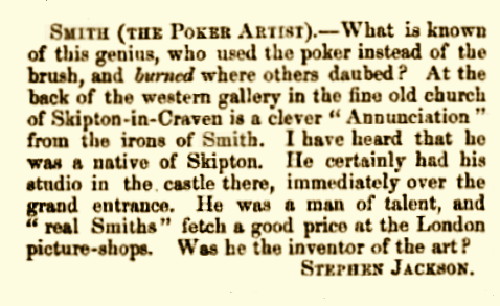 |
| Poker Drawing Thread Originated by Stephen Jackson, December 28, 1867 Adapted from an entry on page 524 in a column from Notes and Queries, 3rd S. XII. December 28, 1867. Oxford University Press, 1867. |
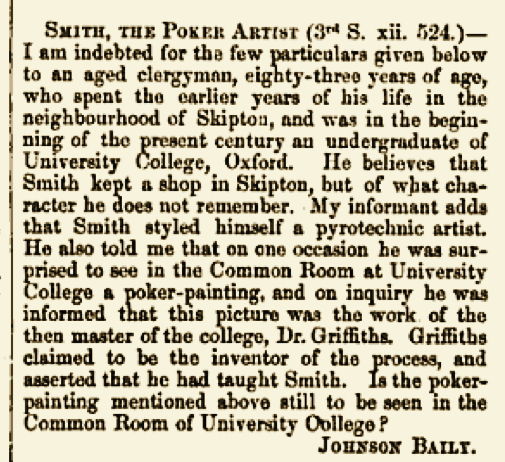 |
| Poker Drawing Thread by Johnson Baily, February 8, 1868 Adapted from an entry on page 135 in a column from Notes and Queries, 4th S. I. February 8, 1868. Oxford University Press, 1868. |
 |
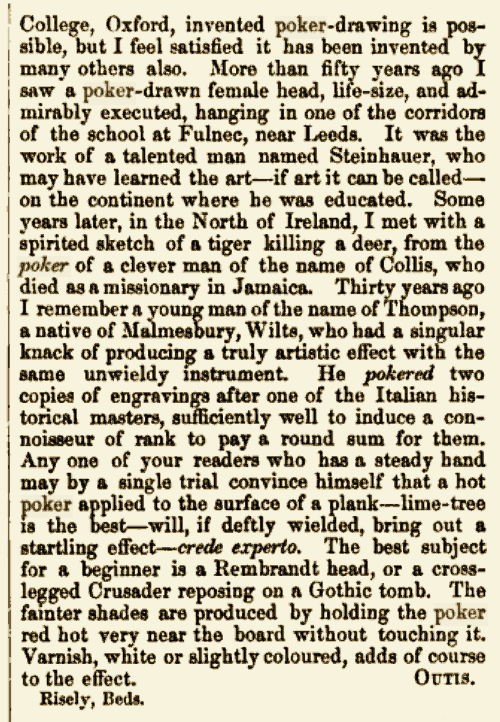 |
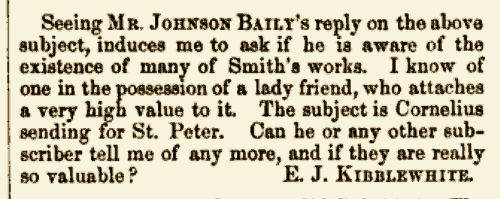 |
| Poker Drawing Thread by Outis and E. J. Kibblewhite, February, 1868 Adapted from entries on page 211 in a column from Notes and Queries, 4th S. I. February 29, 1868. Oxford University Press, 1868. |
 |
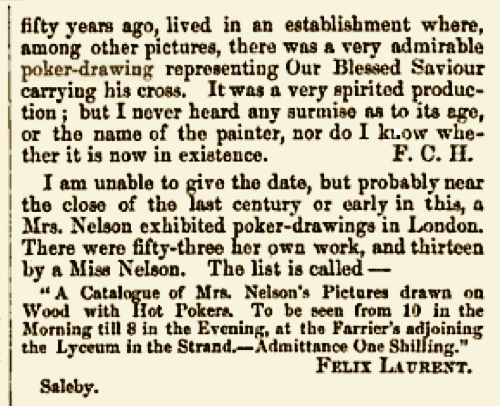 |
| Poker Drawing Thread by F. C. H. and Felix Laurent, March, 1868 Adapted from entries on page 278 in a column from Notes and Queries, 4th S. I. March 21, 1868. Oxford University Press, 1868. |
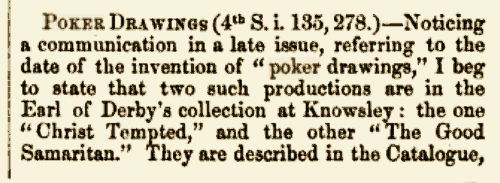 |
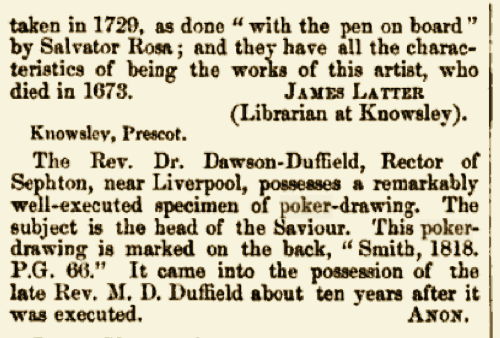 |
| Poker Drawing Thread by James Latter, Library at Knowsley, and Anon., March 28, 1868 Adapted from entries on pages 302–303 in a column from Notes and Queries, 4th S. I. March 28, 1868. Oxford University Press, 1868. |
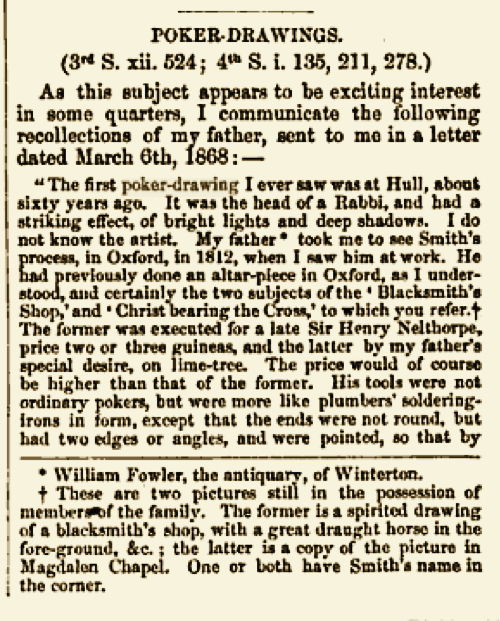 |
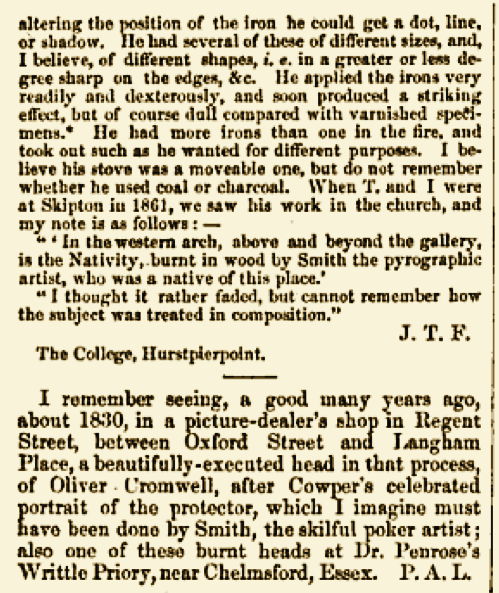 |
| Poker Drawing Thread by J. T. F., The College, Hurstpierpoint, and P. A. L., April 11, 1868 Adapted from entries on pages 347–348 in a column from Notes and Queries, 4th S. I. April 11, 1868. Oxford University Press, 1868. |
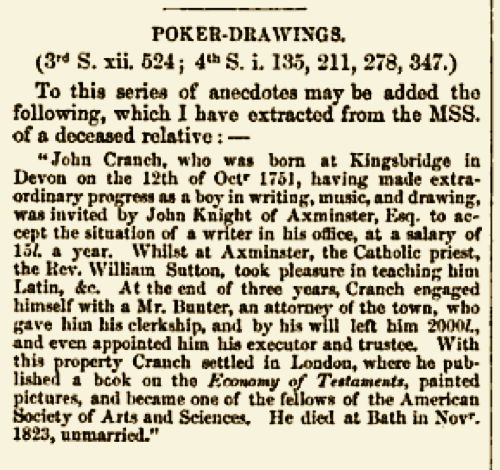 |
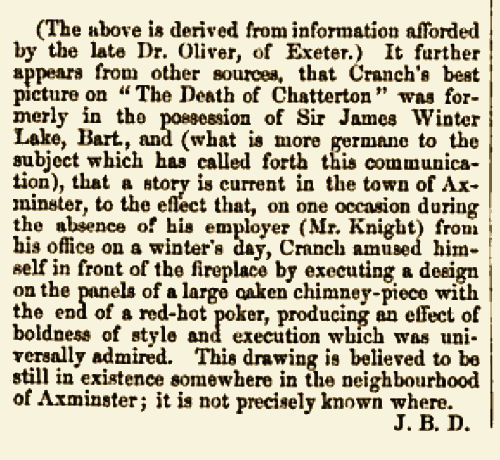 |
| Poker Drawing Thread by J. B. D., June 6, 1868 Adapted from an entry on page 542 in a column from Notes and Queries, 4th S. I. June 6, 1868. Oxford University Press, 1868. |
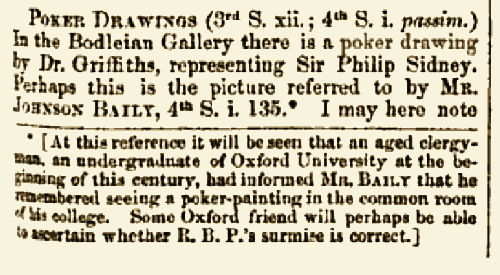 |
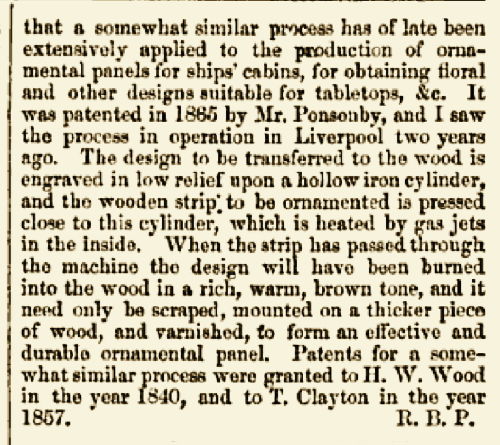 |
| Poker Drawing Thread by R. B. P., July 29, 1871 Adapted from an entry on page 93 in a column of Notes and Queries, 4th S. Vol. VIII, July 29, 1871. The Philosophical Institution Edinburgh, Oxford University Press, 1871. |
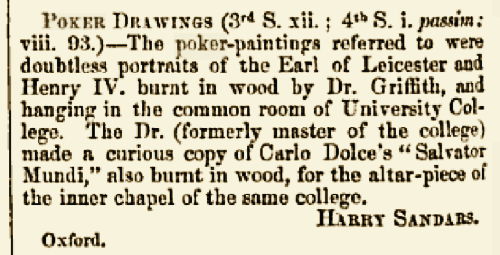 |
| Poker Drawing Thread by Harry Sandars, Oxford, 1871 Adapted from an entry on page 176 in a column from Notes and Queries, 4th S. Vol. VIII, July 29, 1871. The Philosophical Institution Edinburgh, Oxford University Press, 1871. |
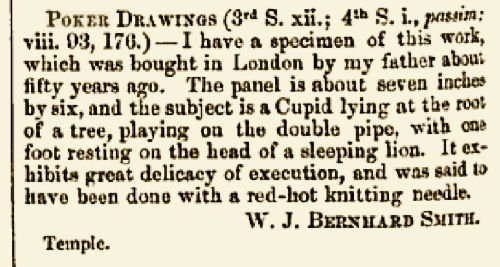 |
| Poker Drawing Thread by W. J. Bernhard Smith, Temple, July 29, 1871 Adapted from an entry on page 272 in a column from Notes and Queries, 4th S. Vol. VIII, July 29, 1871. The Philosophical Institution Edinburgh, Oxford University Press, 1871. |
A remarkable publication, designed back in the mid 1800's to work much the way a thread works on an internet mailing list today, "Notes and queries" posted a query from a reader, Stephen Jackson, whose opening comment was initially about Smith. The thread soon expanded when Johnson Baily noted seeing a work by Dr. Griffith in the Common Room of University College, Oxford. He includes Dr. Griffith's claim to have invented poker drawing, and asks whether the poker-painting mentioned was still in the Common Room of University College. The thread that followed failed to answer the specific question of what happened to Smith the pyrographist as the artist signed himself, but instead the topic became about who had, in fact, invented pyrography and who else was noted for it. This exhibit represents all of the replies, which came in from the initial query in December of 1867 to 1871 gathered in one place.
We also learn from the first reply that Dr. Griffith not only claimed to have invented poker drawing but also to have taught Smith! To the former claim, another correspondent makes a delicate disclaimer by saying that he believes others may also have "invented" poker drawing. This is a very nice way of expressing it and perhaps more truthful than diplomatic when we consider that over the centuries, pyrographic artists have often, in fact, usually, worked alone. This isolation means that they actually do invent using burning as an art form, or their use of shading in addition to line work, or thinking to add color to it, etc. Since no one taught them, to a certain degree it is indeed their invention, even if others before, at the same time, and even later have also done the same thing drawing on their own ingenuity.
Of particular value in these responses is the fact that they were all very personal. They add interesting bits of information about each artist. In addition, they give us an idea of how well known poker work was back then and even 30–60 years before (as some writers mention things from years before that they had seen and remembered, and even accounts by other people they know). It was obvious that the pyrography works were rare, as the same artists were mentioned repeatedly. None mentioned that poker drawing had become a popular pastime in the 1820's or 30's, as was noted in an 1859 article.
One writer, Outis, offers a wealth of information. He mentions an artist—Steinhauer—and his life-size portrait of a female head (no title). Although the artist's work is noted as being at Fulnec, near Leeds, Outis tells us that he was from "the continent," probably meaning that he was from Moravia (Czech Republic). Steinhauer was heretofore unknown.
In that account, after Outis mentions Steinhauer's excellent work, he then puts between dashes a disclaimer, i.e., "if art it can be called." The answer, of course, is a resounding yes. Especially so, if we consider the artists discussed, viz., Joseph Smith (whose first name is never used); Dr. James Griffith (misspelled as 'Griffiths' throughout) of Oxford; and John Cranch, all three famous figures even in their own time, i.e., starting in the Eighteenth Century and into the Nineteenth. The Knowsley Librarian himself, James Latter, comes forward to point to Salvator Rosa from the Seventeenth Century, whose two works were cited in their 1729 catalogue (and still there at Knowsley back then).
There were other random insights offered, such as that Smith, who we know often signed his works "Smith, Pyrographist," "styled himself a pyrotechnic artist." This was probably a mistake in word choice by the writer Johnson Baily.
J.T.F. (presumably J.T. Fowler), however, did refer to Smith as a "pyrographic" artist, which tells us that the word pyrography was at least known back then, even if not in common usage the way the terms "poker drawing" and "poker work" were. Some writers seemed to make the distinction when it was fine art work.
Of all of the artists, Smith was the one most mentioned; in addition, his tools were described. Moreover, several of his works were identified, as follows:
1. Cornelius Sending for St. Peter
2. Head of the Saviour
3. The Blacksmith's Shop
4. Christ bearing the Cross
5. The Nativity
6. Head of Oliver Cromwell
7. Untitled Portrait (Head)
If you have either any questions to ask or any additional information to offer on this 1867–1871 pyrography thread from Notes and queries, please e-mail the E-Museum Curator.
You are leaving the exhibit of the 1867–1871 topic
"Poker Drawing"
You can return to the
Antique Hall,
or the Book Store and E-Museum Library,
or continue on your tour to one of the following:
Pyrographic Art Exhibit Halls:
Portraits and Paintings
Decorative and Applied Art
Sculpture
Folk and Traditional Art
Children's Pyrographic Art
Special Pyrographic Art
Pyrography Tools and Techniques
Your questions and comments are welcome and appreciated. Please e-mail the E-Museum Curator.
Back to E-Museum Entrance homepage
© 2011 Kathleen M. Garvey Menéndez, all rights reserved.
7 February 2011. Updated 24 February 2011. Updated 27 September 2011. Last updated 20 October 2011.

